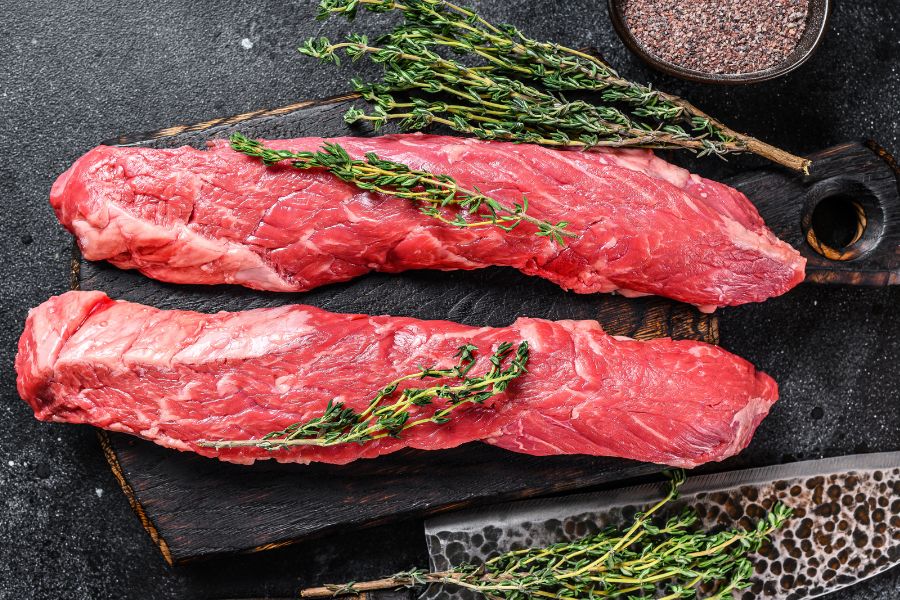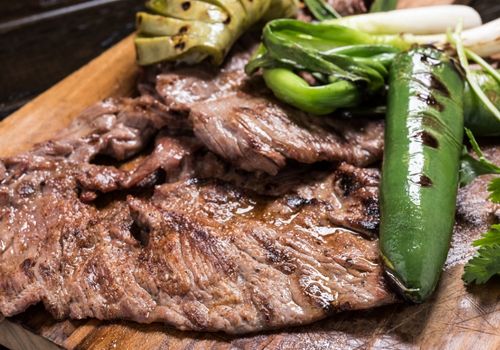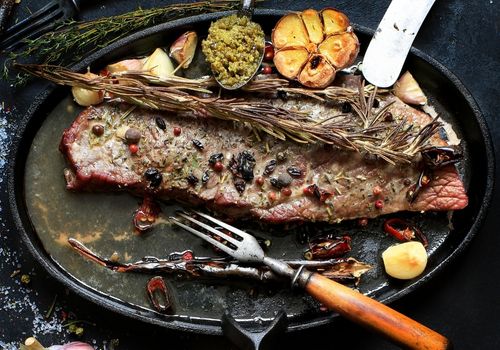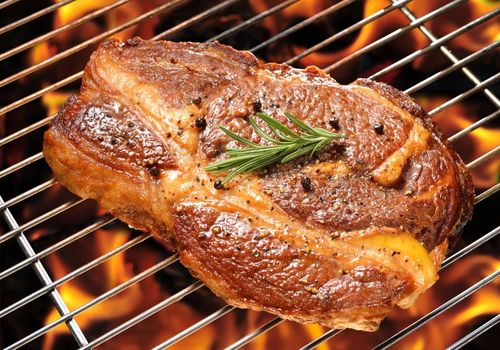Ranchera meat refers to skirt steak, a cut of tough meat from the lower abdominal muscle of the steer. It is the most common cut of meat used to make the Mexican staple, carne asada. Ranchera meat first caught my attention when I tried out an authentic Mexican recipe I found online.
Since then, I have used the carne asada recipe regularly to make a large batch and keep it in the fridge to snack on for at least 3 days. This way, I almost never run out of snacks and easy meals that I can assemble in a flash.
In this article, I will show you how to turn an otherwise tough cut of meat into a savory meal of delicious grilled steak. Let’s get started.

Ranchera meat refers to flank steak or skirt steak. In some areas, it is also used to refer to flap steak.
Flank steak or skirt steak is often confused with flap meat and while they may share similar characteristics they are not the same thing.
Flank or skirt steak is a long flat cut of meat taken from the lower chest or the abdominal muscle of the cow behind the plate. It is a tough cut of meat making it ideal for this recipe.
Flap steak on the other hand is located farther back on the steer and is cut from the bottom sirloin. It is also tough and chewy which is why it is often used as a substitute for skirt steak in ranchera meat recipes.
Related Reading
Ranchera meat is rather lean and has little to no marbling.
The meat is also tough, chewy, and fibrous which makes it the best option for the recipe above.
Ranchera meat also lends itself well to marinating since the tough fibrous steaks do not fall apart during curing.
The steaks are also ideal for slow moist cooking such as braising.
Ranchera meat has an intense beef flavor.
The literal translation of carne asada in Engish is ‘grilled meat.’ It refers to a way of cooking and treating meat more than specific skirt steak recipes.
The term refers to marinating and grilling meat that can be included in several dishes or as part of a larger recipe.
Ranchera is a staple in Mexican cuisine and has become a highly popular part of restaurant cuisine and fast food menus.
Prep time: 24 hours | Cook time: 5 – 10 minutes

Sear the Jalapeno peppers in a skillet or bake them for approximately 5 minutes to give them a charred flavor.
Put the peppers, orange juice, lime juice, white onion, cilantro, apple cider vinegar, garlic, olive oil, soy sauce, cumin, chili, oregano, sugar, and salt in a food processor and blend into a smoothie.
If it is too thick, you can add a dash of olive oil, soy sauce, or apple cider vinegar and process again. The mixture needs to pour easily.
In a mixing bowl, place the skirt steak and pour the marinade into it. Mix the marinade into the meat ensuring that it’s well-coated.
Place the meat in the fridge and let it marinate for at least 2 hours. Marinating skirt steak overnight will give you even better results.
Remove the steak from the fridge and place it on a cutting board. Pat down the steaks using paper towels to dry off as much of the marinade as possible. Do not rinse the steak in water.
If you have marinated the ranchera overnight, discard it but if you marinated it for 2 hours, then you can make a thick tasty gravy using the marinade.
You can grill or pan-sear the steak at this point.
Heat the grill to 450 degrees Fahrenheit. You want a high temperature to grill the meat quickly and prevent it from cooking for too long.
Place the steak on the grill and let it cook on either side for no more than 3 minutes.
Alternatively, place the skillet on the stove and set the flame on high. You may have to cut the steak into halves and cook one half at a time.
Pour a dash of olive oil into the pan and spread it.
Place the steak into the pan and let it sear on high heat for a maximum of 3 minutes on each side.
Your carne asada is ready, so let it rest for approximately 10 minutes before slicing it.
Slice the carne asada into thin strips against the grain. The grain is the direction of the meat fibers so cutting against it is simply slicing perpendicular to those lines.
Always cook ranchera and let it rest before slicing it. It is easier this way.
Slicing ranchera against the grain also makes eating it easier since the bites will come apart easily.
The recipe above is not standard and several alternative ingredients can be used if you do not have the exact components above. You can use the following substitutes:
Lime juice, lemon juice, or orange juice. If you have none of these, you can use bottled lime juice or bottled orange juice.
For a strong citrusy flavor, use a whole cup of lime juice.
Soy sauce can be replaced with Worcestershire sauce or Maggi seasoning.
Red or yellow onion can be used instead of white onion. Onion powder is also a good option if you don’t have fresh bulbs.
For a sweet and smoky flavor, add more onion powder and soy sauce.
Cilantro can be substituted with parsley.
Fresh garlic cloves beat garlic powder hands down but you can use garlic powder in place of the fresh stuff.
Jalapeno peppers can be substituted with just about any pepper that you prefer.
Olive oil can be replaced with any vegetable oil you like. You can also use canola and sunflower oils.
Chili powder can be replaced with red pepper flakes, black pepper, or chipotle powder. Pepper flakes are quite hot, so ensure that they don’t overpower the overall flavor of the marinade.
You can use white wine vinegar, red wine vinegar, or sherry vinegar in place of apple cider vinegar.

The most important element in cooking ranchera meat is the temperature. A heavy cast iron skillet may seem like a good idea since it absorbs a lot of heat but it also cools down very slowly.
This means that the cast iron skillet retains heat after you have turned off the flame and will continue to cook the meat beyond the 3-minute mark.
Cast iron carne asada will overcook instead of resting. Use a normal skillet that will heat up quickly and also lose heat fast to prevent this. Excellent grilled beef should be rare or medium rare to retain the beefy flavor.
You have an array of options and just about any dish can be served with carne asada. Serve it as a snack or a meal with any of the accompaniments below.
Related Reading
No. Flap meat is a thin slice of meat retrieved from the bottom sirloin cut of beef.
Flank meat is retrieved from the flank, which is a cut that is located in the lower region of the abdominal area just behind the plate.
Because it is typically tough and fibrous, the best cooking methods are braising and grilling. In either case, ranchera must be tenderized extensively by marinating or curing the meat.
Without any form of marination, these cuts would take too long to cook and lengthy cooking could ruin the overall flavor of the meal.
When cured just right, these cuts are a dream meal and make delicious stews and accompaniments.
Braising or bistec ranchera is ideal since these cuts lack fat and could become dry without the extra moisture that braising involves.
Braising also cooks ranchera steak slowly so that the fibers do not shrink and shorten in high heat making them too chewy to be edible.
Marinating ranchera overnight makes the steaks tender enough that they only need to be seared on high heat, leaving the inside fairly juicy and still retaining the flavor of the marinade.

Carne asada meat is a darling snack that can be kept in the fridge for 3 – 4 days. Put it in an airtight container first.
Keeping it for any longer is not recommended and bacteria will begin to develop, making it potentially dangerous to consume.
If you must keep this meat any longer than three days it would be better to store it in the freezer. It can last up to three months without deteriorating in quality.
Put the meat in a plastic or Ziploc bag and squeeze out all the air. If you can, vacuum seal the bag to eliminate as much air as possible.
Eliminating the air protects the food from freezer burn. Label the bag with the date and place it in the freezer.